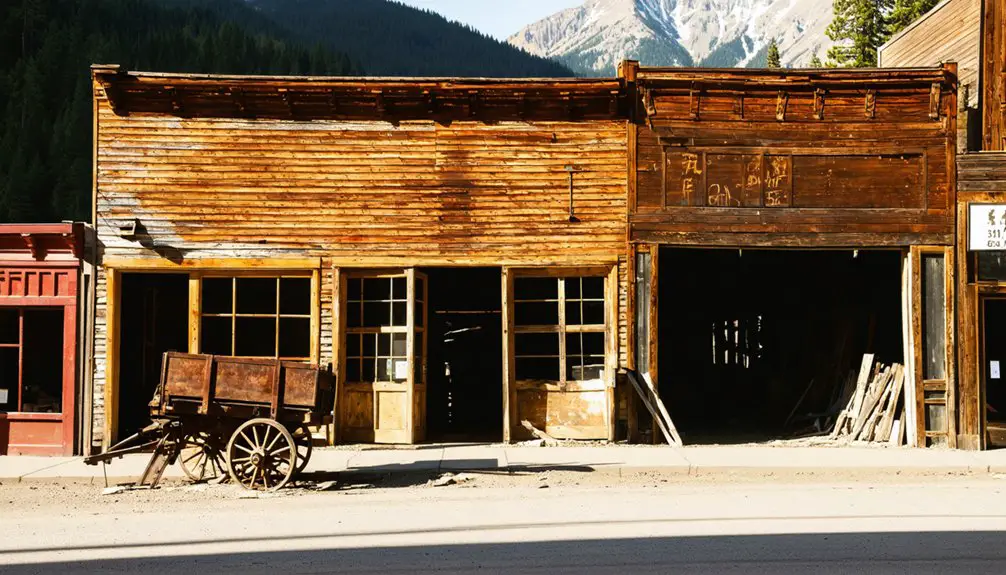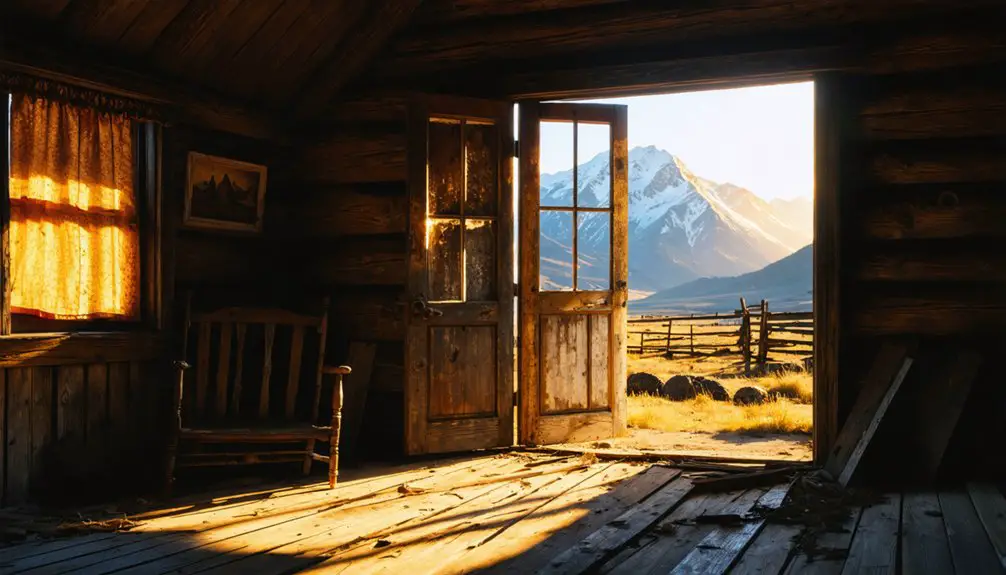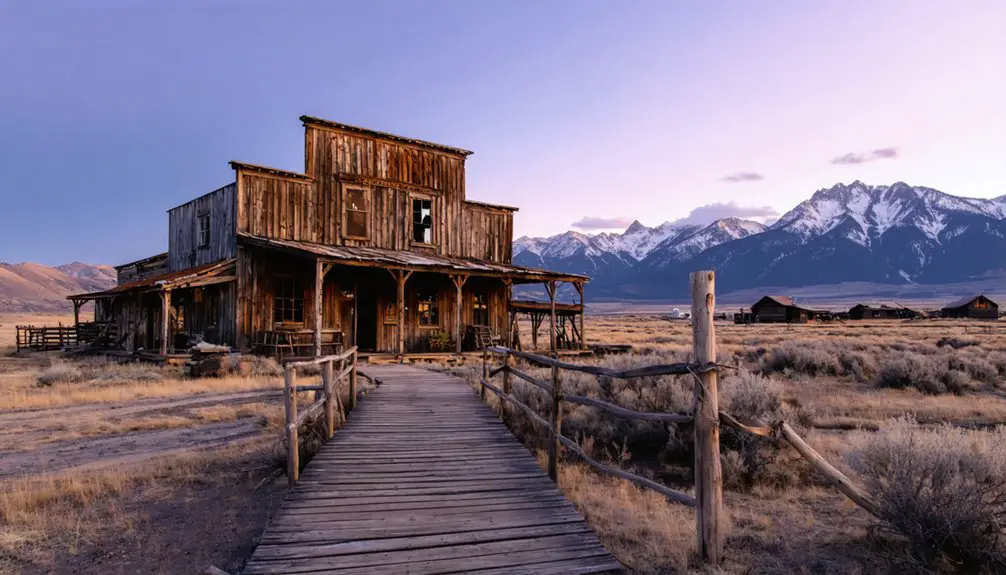You’ll discover Ruby Gulch tucked away in Montana’s mining country, where a bustling community of 2,000 once thrived during the early 1900s. The town’s innovative cyanide mill processed ore worth $14,000 in gold daily, yielding over 308,000 ounces between 1904 and the 1950s. Despite fires in 1912 and 1936, the resilient town persisted until its eventual decline. Today, the ghost town‘s weathered buildings and untapped deposits tell a fascinating story of Montana’s golden frontier.
Key Takeaways
- Ruby Gulch began as Montana Camp in the 1880s and grew into a prosperous mining town producing $14,000 in gold daily.
- At its peak in the 1920s, Ruby Gulch housed 2,000 residents and featured a revolutionary cyanide mill for processing ore.
- The town’s infrastructure included a general store, log cabins, a white clapboard church, and numerous miners’ shacks.
- Multiple fires, World War I shutdowns, and environmental issues from cyanide processing challenged the town’s sustainability.
- Today, Ruby Gulch stands as a ghost town with historic structures and an estimated $10-15 million in untapped gold deposits.
From Montana Camp to Ruby: A Mining Town’s Birth

While prospectors initially discovered promising mineral deposits in the mid-1880s, Ruby Gulch‘s story began as a modest mining camp known as Montana Camp.
You’ll find the early miners faced significant mining challenges as they battled scarce water resources and poor extraction methods while working the area’s rich veins of lead, copper, and zinc near the Montana Mine by 1891.
Despite the dangerous environment and frequent hostile attacks due to the camp’s proximity to the Mexican border, the community’s resilience shone through.
The miners’ unwavering spirit prevailed against border violence, proving that determination could overcome even the most challenging circumstances.
A turning point came in 1903 when George Cheyney established the first general store, marking the beginning of proper commercial infrastructure. This development helped transform the rugged camp into a more established settlement, setting the stage for its future growth as the mine would later produce up to fourteen thousand dollars in daily gold production by 1904.
Gold Rush Glory Days and Peak Production
After decades of modest mining activity, Ruby Gulch catapulted into its golden age around 1904, when daily gold bullion production soared to an astounding $14,000.
You’d have witnessed the region’s transformation as gold mining drew nearly 2,000 residents to this once-remote mountain area by the early 1920s.
The economic impact was unprecedented, with Ruby Gulch emerging as the most prosperous operation in the Zortman area.
The mine’s success hinged on its world-class cyanide mill, which revolutionized the processing of low-grade ore that earlier methods couldn’t handle.
Though fires in 1912 and 1936 dealt serious blows, and World War I forced a temporary shutdown, the mine’s resilience prevailed.
Life in a Booming Mining Community

Life in Ruby Gulch centered around the steady rhythm of mining operations, with the town of Whitcomb nestled in a steep gulch near the Little Rockies serving as home to nearly 2,000 residents by the early 1920s.
Community dynamics reflected the frontier spirit, with miners and their families creating a tight-knit society amid labor struggles and economic uncertainty. Like other mining communities of the era, miners formed quasi-municipal organizations to establish local governance and create mining laws.
Daily life revolved around mining schedules, with workers producing up to $14,000 in gold bullion per day during peak times.
You’d find a distinctive blend of architecture throughout town:
- Historic log cabins stood shoulder-to-shoulder with modern buildings
- A white clapboard church perched above town, anchoring the community’s spirit
- Miners’ shacks and trailers dotted the landscape, telling stories of different eras
- The world’s second-largest cyanide mill dominated the industrial landscape
Mining Innovation and the Famous Cyanide Mill
The innovative cyanide mill at Ruby Gulch revolutionized gold mining in Montana’s Little Rockies when Pete Zortman and his partner constructed it in 1904.
You’d have seen the mill transform previously worthless low-grade ore into profitable yields, producing up to $14,000 in gold daily. As the world’s second-largest facility of its kind, the cyanide technology enabled the recovery of over 308,000 ounces of gold from the district.
While the mill faced multiple setbacks, including devastating fires in 1912 and 1923, operations consistently resumed until the 1950s. The mill was significantly enlarged in 1914, reflecting the operation’s growing success.
However, you can’t ignore the environmental impact – the legacy of cyanide mining left lasting contamination, including a 50,000-gallon cyanide spill into Zortman’s water supply.
The devastating environmental toll of cyanide mining scarred Montana’s landscape, poisoning local water supplies and leaving a toxic legacy behind.
These concerns eventually led Montana to ban new cyanide heap-leach operations in the late 1990s.
The Ghost Town’s Enduring Legacy Today

Modern-day Ruby Gulch stands as a tribute to Montana’s rich mining heritage, though its physical remnants tell a complex story of both prosperity and decline.
While access is limited, the ghost town’s cultural preservation efforts protect an estimated $10-15 million in untapped gold deposits alongside irreplaceable historical structures that survived the 1935 fire.
- You’ll find echoes of frontier spirit in the remaining buildings, where determined miners once extracted $125 million in regional wealth.
- The site embodies the raw freedom of the American West, preserving stories of those who risked everything for golden dreams.
- Despite restricted access, the town’s economic potential remains significant if gold prices rise.
Like the well-preserved buildings in Garnet, which stand at 6,000 feet elevation in Montana’s rugged mountains, each weathered structure represents the resilient communities that shaped Montana’s mining legacy through boom and bust.
Frequently Asked Questions
What Dangerous Wildlife Can Visitors Encounter in Ruby Gulch Today?
Like a shadow in moonlight, mountain lions stalk Ruby Gulch’s trails. You’ll need to watch for grizzly and black bear encounters, while snake sightings are possible but rare in warmer months.
Are There Any Reported Ghost Sightings or Paranormal Activity in Ruby Gulch?
You’ll find plenty of ghost stories and local legends here, with reports of shadow figures in the saloon, disembodied voices in the brothel, and unexplained cold spots throughout historic buildings.
What Is the Best Time of Year to Visit Ruby Gulch?
While winter’s brutal, you’ll find your sweet spot from late spring through early fall, when mild temperatures and extended daylight hours make exploring comfortable, and you’ll catch peak tourist activities nearby.
Can Visitors Legally Collect Artifacts or Minerals From Ruby Gulch?
You can’t legally collect artifacts due to preservation laws. While surface mineral collection might be allowed depending on land jurisdiction, you’ll need to verify specific regulations before collecting anything.
How Accessible Is Ruby Gulch During Winter Months?
With snowfall averaging 60+ inches annually, you’ll find limited winter accessibility. You can’t drive past the gated Woods Creek Road, but you’re free to access by snowshoe, ski, or snowmobile.
References
- https://www.gvrhc.org/Library/Ruby.pdf
- https://www.mtghosttowns.com/zortman
- https://www.garnetghosttown.org/history.php
- https://www.altaonline.com/dispatches/a6466/ghost-town-wild-west-laura-fraser/
- https://westernmininghistory.com/towns/montana/zortman/
- http://www.usa-ti.com/Arizona/Ghost_Towns/Ruby/brochures/2004_The_Private_Life_Of_Ruby-Mining_GhostTown.pdf
- https://www.legendsofamerica.com/az-ruby/
- https://missouririvermt.com/community/zortman
- https://mhs.mt.gov/education/textbook/chapter6/Chapter6.pdf
- https://digitalcommons.mtech.edu/bach_theses/234/



